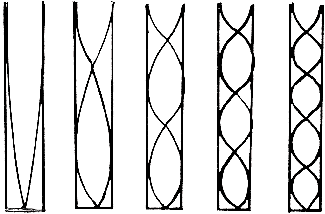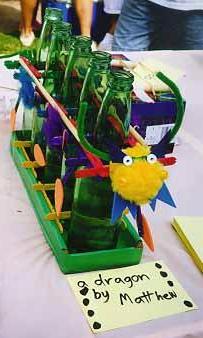


| Title: | Location | K-4 | 5-8 | 9-12 | Description | Discipline |
| Winds & Brasses Blow | SoundGarden | How can you use wind to make sound? |
Wind instruments are among the oldest type of instrument known to humans. Wind instruments include the flute, clarinet, oboe, saxophone, trumpet, trombone, french horn, tuba, bagpipes, and bassoon (just to name a few).
Wind instruments are usually made out of metals like brass, silver, or gold. Some like the clarinet and bassoon are made out of wood. To make wind instruments sound, you usually blow air into or across them to make the air inside vibrate.
Name That Instrument!
Let's play a quick game called Name That Instrument! Can you tell what kind of wind instrument is being played? Can you tell how it makes a sound?
How do you think each of those instruments made a sound? Write down each of your answers in your Journal.
What happens when the air inside a wind instrument vibrates?
There are many ways to make a column of air vibrate. You can:
- - blow across an opening (flute)
- - use a mouthpiece (trombone)
- - use two reeds (oboe).

What happens when a column of air vibrates?
A column of air, open at one end like a bottle, vibrates in halves, thirds, fourths, fifths, and so on to create a pitch. Notice that the pattern of vibration is different at the closed bottom than at the open top.
What's the Point?
Every instrument has three parts that combine to create its sound. Though we use some fancy words to desribe these parts, they're really quite simple:
The Primary Vibrator is the part that creates the sound. In a trombone it's the player's lips, in the oboe it's the two reeds, and in a flute its column of focused air coming from the player's lips. All of these are related to The Bernouili Effect.
The Resonant Vibrator is the part that makes the sound louder through a process called resonance. In a flute, trombone, or oboe it's the column of air.
The Sound Effuser is the part that focuses and helps to project the sound toward the audience. In a flute it's the sound hole, in the trombone and oboe it's the flare at the end of the instrument.
Hands-On Activity – Make your own Wind Thing!

Materials needed:
- bottles (5)
- jug of water
- skill sticks (12 or more)
- rubber bands (various thickness and lengths)
- mallets (2 dowels)
- plastic floor casters (2)
- decorations
- glue
- tape
- safety scissors
To Do:
- Caution: be very careful handling the bottles if they're made of glass. Plastic bottles are better.
- Design a bottle holder with your Skill Sticks. The goal is to create a simple frame that organizes your bottles. It is NOT supposed to support the weight of the bottles, just keep them in a straight row.
- Create your frame with the Skill Sticks and glue.
- Decorate your Wind Thing. Make it look like something that represents some aspect of your personality.
- Now fill the water jug, then fill the bottles with water so that they gradually contain more water.
- Blow across the top of the bottle. Form your lips into a round shape, like saying the word "oooh" and blow across the top of the bottle.
- If you have difficulty making the bottle sing, try using a single bottle to practice on for a minute or two.
- Insert the mallet stick into the plastic floor casters. Now you've created a drum stick!
- Now you're ready for some experiments!
Try This
TIP: when performing your tests make sure that you conduct a "fair test" by changing just one thing at a time. This way you will always be able to tell the result. Record your results in your journal so you can compare them.
How many different ways can you make a sound?
How many different ways can you make high and low pitches on a single bottle?
Try changing the amount of water in the five bottles. Can you tune the bottles to make a scale?
Try gently tapping the bottles with your mallets. Which bottle has the highest pitch now? Which bottle has the lowest pitch now?
How can you make loud and soft sounds?
Wind Thing Journal Reflections
- which part is the Primary Vibrator? Why?
- which part is the Resonant Vibrator? Why?
- which part is the Sound Effuser? Why?
- How is pitch effected by different-sized columns of air? water?
- What is the relationship between the air and water?
- What other things might effect the pitch of any bottle (for example, bigger or smaller bottles, etc.)?
- What things effect the loudness of any bottle?
Just for Fun!
Can you create a simple melody? Can you sing or whistle along with it?
Can you create a simple rhythm? Can you sing or hum along with it?
Can you make up a set of lyrics for your song or rhythm?
"Wind over lake:
the image of inner truth."
– I Ching
Send your comments to: webteam@cafemuse.com
© 1996 – 2015 NewWorldView, All Rights Reserved.